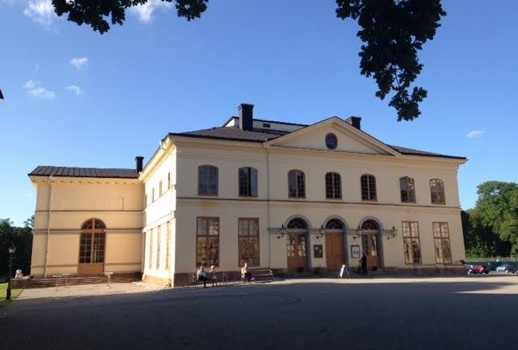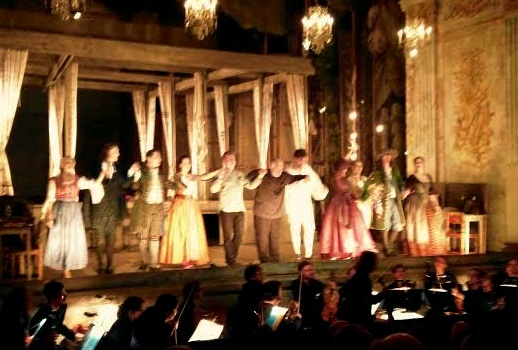
As the date drew closer and the schedule at the Mariinsky continued to fill itself in, I was crestfallen to discover that a mere three days before I arrived the company was going on a three-week hiatus. I cursed the operatic gods and keened at unkind fate. But then it occurred to me that I would be spending days pre- and post- in Stockholm and Copenhagen, and didn’t the Danes build a glorious new opera house a while back that was an architectural masterpiece? But, once again, everyone’s on vacances, and I remained thwarted.
But then internet lightning struck and within 15 minutes of frantic keyboard tapping the clouds parted, the rays of a gracious Mozartian god bathed my work space in luminescence, and I ended up with a ticket to see Le Nozze di Figaro at the Drottningholm Palace Theatre in the bucolic suburbs of Stockholm. Surely this trumped watching Maestro Gergiev and his combover schvitzing all over those poor Russians sawing away in the pit like galley slaves.
None other than the venerable Marc Minkowski would be conducting: he who led my very favorite recording of Handel’s Giulio Cesare. I swooned at the thought of an original instrument performance in that jewel box theater from which I have so many recordings from back in the heyday with Arnold Östman. Naturally I booked the pre-performance tour of the theatre and then tried to keep my hysteria at a reasonable level when people asked me what I had planned for my trip. Normal folk just start looking uneasy when you begin bandying about expressions like “authentic appoggiatura” and “period instruments” at the emotional level normally reserved for discussions of your wedding day or a recent car accident.
The current Drottningholm Palace Theatre was built at the behest of the Swedish Queen Lovisa Ulrika, nicknamed the “Minerva of the North” for her dedication to the arts. The royal family barely having missed perishing in the flames of the first theatre on the same site in 1762 when it burnt to the ground mid-performance. The exterior is plain and painted a pale yellow. The anterooms where composers, performers, and servants, stayed are still papered with original hand-painted fabrics nailed to the walls. Beautifully decorated ceramic ovens in delft style, built into corners floor to ceiling, offer heat on cold evenings. Rooms are small and sparsely furnished. Beds are discouraging in their meagerness.
The theatre itself also disappoints when you first enter in the fresh light of afternoon. You see the Swedish Royals didn’t have a great treasury set aside for such expenditures and the rococo extravagances I’d seen in pictures turn out to be a clever paint job with very little plaster involved. The few three dimensional corbels are executed in papier-mâché, not wood or plaster as they appear. The stalls of the theatre itself are built at a very sharp rake up towards the second story in the back and the padded bench seats are slim, almost giving one the impression of riding a bike through to the last act.
In 1792 the public murder of King Gustaf III, in the Royal Opera House of Stockholm during a masked ball (my, this sounds familiar!), gave the succeeding generations of the royal family a wary outlook on theatricals of any sort and the Palace Theatre fell to neglect. It was used as storage space until 1920, when it was rediscovered and repaired with the help of Swedish theatre historian Agne Beijer. They have 15 original decors for the stage still in use, including a rolling sea and the original wind machine.
So imagine for a moment that you travel all the way to Sweden in an emotional state of operatic high fever to see the first in a new series of productions of the great Mozart/Da Ponte trilogy presented in period performance on one of the last remaining baroque stages in the world… and they don’t use any of the original stage machinery. I am accursed!

For the garden at the final act the drapes were pulled back completely in the rear and only the front to back divisions were used giving the audience a full picture of what was going on. Initially I wanted my money back, including airfarel but ultimately I had to admit it was most clever.
Maestro Minkowski made his way gingerly into the wee pit, which is just a foot or two below the level of the audience, and then danced his way, joyously, through the proceedings. Never have I seen a conductor so in love with his own music making. Maybe because he was so clearly visible but still it was a pleasure watching him coax and guide the performance from his musicians and singers. His gestures varied from the precise counting of beats in the quieter moments to enormous circular swells in the concertato finale of Act II. His reading was highly nuanced and boasted not only a healthy amount of appoggiatura but (brace yourselves) interpolated high notes in some penultimate phrases and, in one case, an alternate aria.
The Drottningholm Theater Orchestra numbered 30 players and they seemed a fairly young bunch. The overture itself was a bit tentative at first and you do have to adjust your ear to the sounds of the period instruments. It was the second performance of a long run and they certainly gained strength as the evening progressed. I should mention Francesco Corti who provided the recitative accompaniment on the fortepiano as if he was being paid by the note.
Interesting in that, to follow along with the commedia conceit, and perhaps save a kroner or two, there was no chorus employed. So any character not involved in the action at that moment trouped on and sang the brief choral moments along with the principals. Very surprising at first but then doubly surprising at how well it worked. In a cast of nine very strong voices the ensembles became gloriously overwhelming in that small space.
The character parts were taken with panache starting with the Barbarina of Hanna Husáhr who was delightfully fresh and sly with her libidinous charms. Just as the singers had done at the first performance in Mozart’s time Anders J. Dahlin did double duty as Basilio and Don Curzio and Paolo Battaglia following suit as Bartolo and Antonio. Both gentlemen gave broad interpretations that were indicative of the production style but totally refreshing in their enthusiasm. Mr. Alexandre certainly wasn’t above the judicious use of low-clowning and made it work in context.
The Marcellina of Miriam Treichl was perhaps too young to have birthed our protagonist but it was a pleasure to hear her music sung with a voice that was mature but not passed its shelf date. Sadly she was deprived of her last act aria.

Lenneke Ruiten was the Susanna and she was a charming and agile minx, a wildcat when crossed but tender in love. Her opening duet with Figaro, when she warned of the Count’s amorous attentions, set the right frank tone to her portrayal. She clearly wasn’t planning on being taken advantage of. Her “Deh vieni” in the last act was languid in all the right ways and included a final cadenza into the stratosphere where she held the highest note for an impossibly long time before a graceful diminuendo and a return to earth with the final cadence. I had shivers.
Robert Gleadow as Figaro and Florian Sempey as the Count where the most evenly matched pair I have ever seen in this opera. Both had rich, strong, voices and athletic, virile, stage presences. Naturally Mr. Gleadow did more than his share of scurrying and scheming but he too was plain in the fact that he was not about to be cowed in his determination to marry.
Mr. Sempey, who, sported a very grand dressing gown, obviously graduated with honors from the Frank Langella school of cape management. Later he gave us a dazzling rendition of the alternate version of the Count’s Act III,’Hai già vinta la causa’. I know it well from various appendices but had never heard it performed live. It lies higher in the voice and is actually a much flashier, if slightly shorter, piece. It sat right in the pocket for Mr. Sempey and he gave it an exhilarating performance and won a very strong ovation.
In a home-grown cast the Countess of Camilla Tilling, a Swede herself, was the standout. Her soprano, of an imposing character due to her clarity of tone and accuracy, proves why she enjoys an international career. “Porgi amor” held no terrors for her and she was has a graceful stage bearing. Her interactions with Susanna and Figaro where all for fun and she showed a strong backbone to the Count in Act II.
The duet with Susanna in Act III was particularly ravishing with the lovely back and forth phrases. Perhaps a larger space might betray the difference in the size of their voices but this close in they had a delicious balance. Ms. Tilling’s final “Piu docile io sono…” held a special radiance.
Mr. Fontaine’s costumes where standard and, although they fit the characters perfectly, they were really more like clothes. Because the playing space was so small there was an understandable uniformity to the designs since the character worked in such close proximity all evening.
One other thing I should mention and that’s the lighting. On the tour they tell you about the candelabra in the walls and the chandeliers. In the 1950’s a gentlemen there invented and patented what is called to this day the Drottningholm Candle. It looks like a regular flame shaped light bulb with a frosted white finish. However it oscillates, oh so slightly, in its position at the top of the faux wax and it really does give the impression of candlelight. Magic.
I’ve seen a few small productions in intimate spaces before but never at this level of music making. A performance of great refinement without being precious in the least. The performers were dramatically alert and not afraid to play to an audience that was almost within arm’s reach. In spite of my disappointment over the absence of the stage machinery it turned out to be one of my greatest evenings in the theater.





Comments